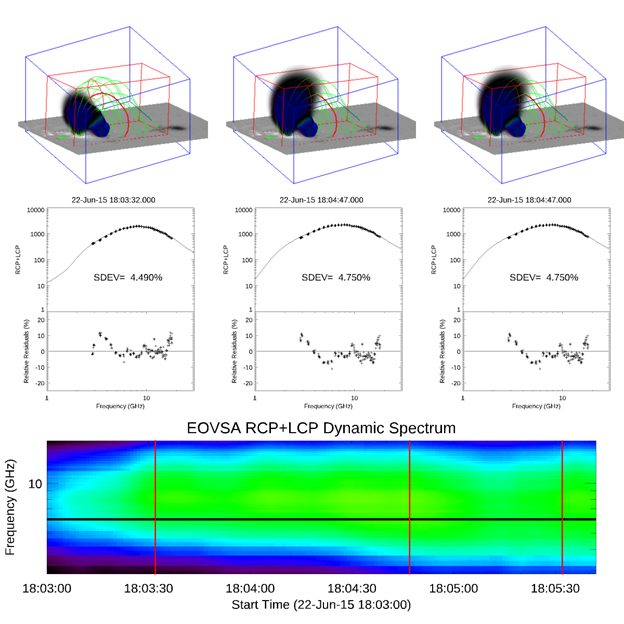In the dynamic realm of modern solar physics, where vast and diverse data sets challenge understanding, a critical need emerges for advanced data-constrained 3D modeling that combines photospheric magnetic fields measurements and a wide range of contextual electromagnetic radiation observations, which includes radio, X-ray, and extreme ultraviolet (EUV) emissions. Bridging all these available observational data constraints is imperative to create a comprehensive understanding of solar activity and phenomena.
Addressing this challenge, we present the GX Simulator framework – a powerful, freely distributed modeling tool (https://doi.org/10.5281/zenodo.7882022) designed to seamlessly blend 3D magnetic and plasma structures with thermal and nonthermal models.
With an object-based modular architecture, GX Simulator offers versatility on multiple OS platforms, enabling the import of 3D density and temperature distribution models or numerically defined coronal and chromospheric properties. This flexibility empowers users to create, fine-tune, and analyze models that capture the complexity of solar phenomena.
One of GX Simulator’s standout features lies in its ability to compute various emissions from a single 3D model. The framework (Figure 1) includes radiation transfer codes for accurate microwave, X-ray, and EUV emission calculations, enhancing the synthesis of observables. Furthermore, GX Simulator’s plugin architecture allows effortless integration of user-supplied radiation transfer codes, broadening its applicability and adaptability to different research requirements.

Figure 1 : Workflow Diagram of the GX Simulator Automatic Model Production Pipeline (AMPP) adapted from Nita et al. 2023.
Our modeling tool not only automates the creation of magnetic models but also introduces objectively defined thermal structures within the corona and chromosphere. By coupling this with radiation transfer calculations, GX Simulator offers a comprehensive platform for comparing synthetic observables with real data (Figure 2). This process ensures rigorous model-to-data comparisons, unlocking deeper insights into the intricacies of solar phenomena.

Figure 2 Example of 3D modeling with GX Simulator for the peak of the SOL2015-06-22T17:50 flare observed with EOVSA (adapted from Nita et al. 2023)
The GX Simulator framework has reached a level of maturity that makes it an asset for both flare and active region science. It addresses diverse modeling needs by providing automatic model creation, synthetic observable generation, and robust data-to-model comparisons. While currently meeting the demands of solar physics, GX Simulator continues to evolve. Planned major upgrades promise expanded functionalities to tackle increasingly sophisticated scientific inquiries.
Furthermore, the GX Simulator development team envisions a path toward greater computational efficiency, platform independence, and accessibility. Plans include transitioning the software infrastructure to modern, open-source languages like Python, facilitating integration with popular research workflows and potentially widening its user base.
In essence, the GX Simulator framework stands as an example to the power of synergy between theory and observation, enabling solar physicists to unravel the mysteries of our dynamic sun and illuminate new horizons in our understanding of solar activity.
Based on a recently published paper by Gelu M. Nita et al, Data-constrained Solar Modeling with GX Simulator, ApJS 267 6 (2023) DOI: 10.3847/1538-4365/acd343
